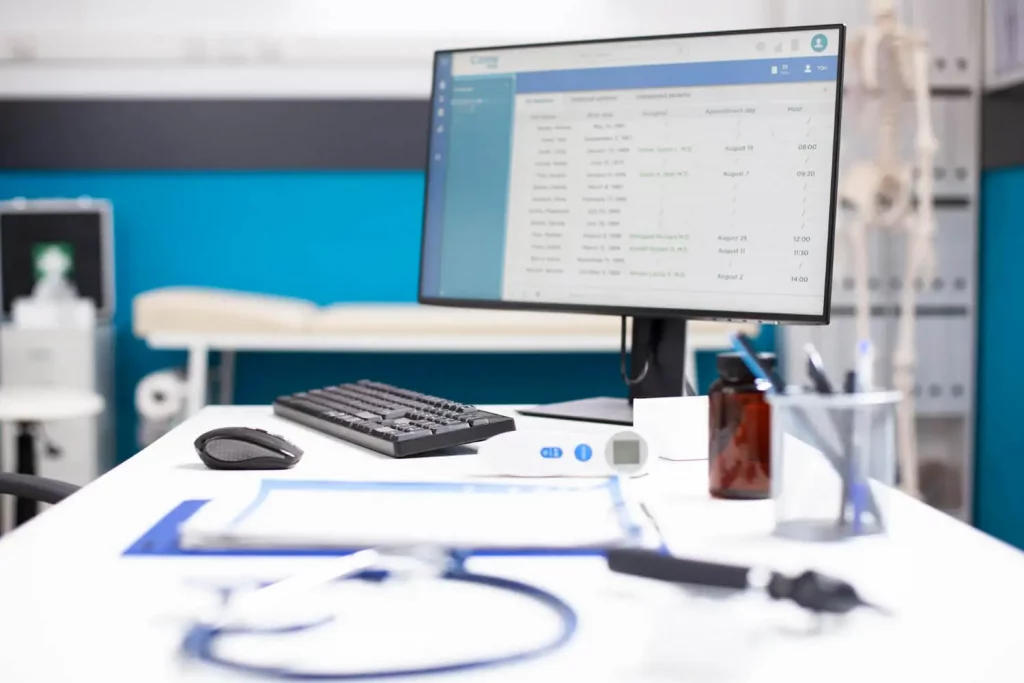Table of Contents
Listen to article
While a number of industries are adopting new technologies to transform workflows, the shift toward digital solutions is perhaps most notable in the healthcare field.
As online solutions become increasingly integrated into standard healthcare practices, expectations are quickly changing for both healthcare providers and patients.
In fact, 77% of patients say that the ability to book, change, or cancel appointments online is important in their choice of a healthcare provider—in other words, if your company doesn’t have an advanced web solution, you may miss out on the opportunity to stay competitive in a growing digital landscape.
Keep reading to learn the role of web development in healthcare—where we’ll discuss everything from must-have features and benefits to the importance of compliance throughout healthcare web development.
What is Healthcare Web Development?
Healthcare web development is the process of creating and maintaining web applications—such as websites, web apps, and web portals—specifically designed to meet the needs of healthcare providers, patients, and organizations.
Often featuring tools like patient portals, appointment scheduling, and telemedicine, medical software development automates tasks, enables remote care, and—most importantly— improves patient outcomes by supporting better data access, AI-driven analytics, and cloud-enabled collaboration across care teams.
Types of Healthcare Websites
While there are a number of different types of healthcare websites that a company can develop, the most common ones include:
Patient Portals
As explained in our previous article, patient portal software can be thought of as a virtual bridge between patients and healthcare providers. Through this online application, patients can do everything from book appointments to view lab results and request prescription refills.
Modern portals are increasingly powered by AI, offering personalized experiences through tailored health recommendations, smart appointment reminders, and predictive insights based on patient history.
Overall, patient portals benefit both healthcare providers and patients by improving engagement, enhancing communication, and making care more convenient for everyone involved.
EHR Systems
EHR systems, or electronic health record systems, are a digital version of a patient’s medical history. Advanced systems document a patient’s entire healthcare journey in real-time, including information such as medical history, diagnoses, medications, treatment plans, and lab results.
Rather than relying on traditional pen-and-paper documentation, EHR systems are designed to streamline workflows, enhance the quality of care, and improve care coordination.
Today, many EHR platforms are cloud-based, leveraging robust infrastructure solutions like AWS for Health or Google Cloud Healthcare to ensure scalability, data security, and seamless access across providers.
Telemedicine & Telehealth Platforms
Telemedicine software is a digital solution that facilitates remote healthcare services. With advanced telehealth technology, patients and healthcare providers can communicate and share information using devices like smartphones, tablets, and computers.
Thanks to virtual consultations, healthcare professionals can diagnose illnesses, manage chronic conditions, and prescribe medications—all without the need for in-person visits. AI technologies are also playing a key role in telemedicine, helping to analyze patient data, provide diagnostic support, and offer personalized treatment recommendations.
Together, these innovations foster clearer communication, improved accessibility, and streamlined healthcare delivery. With the telemedicine sector expected to grow to $432.31 billion by 2032, investing in scalable and secure telehealth solutions is becoming increasingly essential for modern healthcare delivery.
Practice-Focused Websites for Clinics and Dentists
Not all healthcare websites require complex features like EHR systems or patient portals. Many practices benefit from straightforward, well-designed websites that inform patients, highlight services, and reflect the professionalism of the clinic.
Whether you’re launching a site for a dental practice or a general medical clinic, a clean and responsive design can make a lasting impression. These websites can showcase credentials, offer service details, and provide easy contact options—all without the need for heavy backend components.
Our dental website development services at Scopic focus on creating fast, secure, and visually appealing sites tailored to the unique needs of healthcare providers.
A thoughtfully crafted website helps your practice stand out—and connect more effectively with patients in today’s digital-first world.
E-Commerce & Marketplaces for Medical Equipment
Medical equipment sellers increasingly rely on digital platforms to reach healthcare providers and consumers. Whether it’s a full-scale marketplace or a dedicated e-commerce site, a streamlined online store enhances visibility, simplifies purchasing, and builds credibility in a highly regulated space.
These platforms don’t need to be overly complex to be effective—they just need to be fast, secure, and user-friendly. From showcasing product specs to integrating secure payment gateways, every element should support trust and ease of use.
At Scopic, we specialize in e-commerce development services tailored for the medical sector. Our solutions help you launch scalable, compliant platforms that meet your business goals and customer needs.

Must-Have Features in Healthcare Websites
What are the must-have features for a successful healthcare website?
Before jumping into the list of features commonly found on healthcare websites, it’s important to note that not all solutions are the same—and that’s the beauty of bespoke web development.
For instance, a large healthcare organization may use a web portal to organize and streamline internal operations, meaning they may not require features like appointment booking and payment systems.
Patients with chronic diseases, on the other hand, may use online healthcare applications to monitor their conditions and share their results with healthcare providers, meaning they require a personalized health dashboard but may not need access to internal hospital systems.
There are so many use cases we could discuss, so we won’t bore you with every possibility. However, we do think it’s important to highlight the key features commonly found on healthcare websites, including:
- Secure Appointment Booking Systems: This allows patients to schedule, modify, or cancel medical appointments—a feature that saves valuable time for both healthcare providers and patients.
- Patient Portals with EHR Integration: With this feature, patients can securely access their health records, view test results, request prescription refills, and communicate with their healthcare provider, all through a seamless, integrated portal that syncs in real-time with their EHR.
- Telehealth and Video Consultation Modules: The telemedicine market has exploded since the pandemic, with over 116 million users of online doctor consultations worldwide in 2024. That said, companies are increasingly prioritizing telehealth features in their healthcare web development to ensure patients have access to care from anywhere.
- Billing, Payments, and Insurance Verification: This feature enables patients to easily view and pay medical bills, check insurance coverage, and verify claims status directly through a secure portal, streamlining the financial process for both patients and providers.
- Health Trackers and Personal Dashboards: Health trackers—such as blood pressure monitors and glucose meters—provide patients with valuable insights into their health, helping healthcare professionals catch risks early on and enabling more timely, proactive interventions. When healthcare organizations provide patients with a personalized and intuitive dashboard, they can take more control of their health—an important factor in the increasingly health-conscious world.
Key Benefits of Having a Healthcare Web Solution
It seems like from one moment to the next, everybody was online. That said, companies that want to stay competitive in today’s technology-driven world must leverage custom healthcare web development to create a unique web solution that sets them apart.
But don’t just take our word for it—here are the top benefits of web app development for healthcare:

Improved Patient Engagement and Satisfaction
By overcoming common challenges in healthcare—such as long wait times and poor care coordination—digital healthcare solutions encourage individuals to take a more proactive role in managing their health. This convenience improves the patient’s experience and fosters stronger engagement, especially among tech-savvy individuals.

Operational Efficiency and Automation
Custom web platforms can automate repetitive tasks such as appointment reminders, intake forms, billing workflows, insurance verification, and more, allowing clinics to focus more on patient care and reduce overhead costs.

Telehealth and Remote Care Enablement
With remote care on the rise, it’s more important than ever to develop a web solution that supports secure video consultations, remote patient monitoring, chat-based triage, and follow-ups. This ensures you meet the growing demand for virtual care and stay competitive in an evolving market.

Data-Driven Insights and Analytics
In addition to streamlining complex processes and improving user experience, websites can provide companies with valuable insights into patient behavior, most-used services, booking patterns, and content engagement, among others. This helps you make more informed decisions, personalize your services, and reduce expenses.

Competitive Advantage and Branding
A key aspect of custom web development for healthcare is that the web solution caters to the unique needs of each business and its target audience. This ensures you create a strong, on-brand online presence that builds trust and authority.

Scalability and Future-Proofing
Comprehensive web design and development not only considers your current needs but also your future growth to ensure your company is ready to scale. From adding new services to integrating new technologies like AI and IoT, custom platforms can grow alongside your practice.
Navigating the Challenges of Healthcare Web Development
Web development doesn’t come without its challenges. However, an experienced web development company knows how to navigate potential obstacles in order to create intuitive, compliant, and innovative healthcare solutions.
Keep reading to explore some of the key considerations during web app development for healthcare.
HIPAA and Other Regulatory Frameworks
HIPAA and other regulatory frameworks are designed to ensure the privacy, security, and compliance of healthcare information. They provide guidelines for healthcare providers and organizations to safeguard patient data while maintaining the highest standards of care and legal responsibility.
With Scopic’s healthcare development solutions, your software will comply with all applicable regulatory requirements, including:
HIPAA
The Health Insurance Portability and Accountability Act, or HIPAA, establishes federal standards protecting sensitive health information from disclosure without the patient’s consent. To ensure compliance, healthcare providers use HIPAA-compliant software solutions, which safeguard individuals’ rights to control and understand how their health data is used, ultimately protecting public health.
HITECH
The Health Information Technology for Economic and Clinical Health Act, or HITECH, promotes the adoption and meaningful use of health information technology while addressing privacy and security concerns associated with the electronic transmission of health information. This act holds healthcare organizations accountable for any data breaches and imposes penalties for non-compliance with privacy and security regulations, thereby ensuring patient information remains protected.
GDPR (for global applications)
The General Data Protection Regulation, or GDPR, is Europe’s data privacy and security law that sets guidelines for the collection and processing of personal information from individuals. While passed by the European Union, it imposes obligations on organizations worldwide—provided they target or collect data related to individuals in the EU—and enforces fines for those who violate its privacy and security standards.
PIPEDA (Canada)
The Personal Information Protection and Electronic Documents Act, or PIPEDA, establishes rules for how private-sector organizations collect, use, and disclose personal information during for-profit, commercial activities across Canada. There are 10 fair information principles that businesses are subject to, including accountability, identifying purposes, consent, individual access, and more.
Data Security Best Practices
To adhere to the above regulations, healthcare web developers must build with compliance in mind. In addition to following country-specific requirements, there are multiple strategies developers can implement to ensure data security in healthcare web development.
Common data security best practices include implementing strong encryption methods, role-based access control, and conducting regular security audits—all of which help to safeguard sensitive health information and maintain the integrity of healthcare systems.
This not only ensures healthcare companies remain compliant but also builds trust with patients— an important factor in fostering long-term relationships and improving patient outcomes.
Authentication and Access Control Mechanisms
Robust authentication and access control mechanisms are essential to securing sensitive patient data and ensuring compliance with regulations. By implementing strong methods like multi-factor authentication and role-based access, healthcare organizations can prevent unauthorized access and protect patient privacy.
In addition to safeguarding patient information, these measures help companies avoid costly fines and reputational damage due to data breaches.

Emerging Trends in Healthcare Web Development
Staying ahead of web development trends ensures your company stays competitive in the constantly evolving digital landscape.
Here are the top trends your company should know about:
AI-Powered Chatbots and Virtual Assistants
The adoption of AI in web development is on the rise, with AI-powered chatbots and virtual assistants having a major impact on the healthcare industry. There are a number of ways to use chatbots in healthcare, including automated customer service, appointment scheduling, and 24/7 access to health information such as symptom assessments, medication reminders, and supportive resources.
Blockchain for Secure Medical Records
Blockchain represents a potential tool to solve the shortcomings of EHRs in terms of interoperability and privacy, enabling patients to access their complete medical histories in one place and relieving healthcare providers of the burden of lifetime medical data stewardship. In fact, the adoption of blockchain can save healthcare organizations $100-$150 billion per year in costs related to data breaches.
That said, there are still challenges that must be overcome, such as regulatory concerns, energy consumption, and gaining trust from both healthcare providers and patients.
IoT and Remote Monitoring Devices
IoT is transforming remote patient care by enabling real-time data collection, analysis, and intervention. This technology allows healthcare providers to monitor patients’ vital signs continuously, improving early detection of potential health issues and facilitating more personalized treatment plans. Even more, IoT devices help reduce hospital readmissions and healthcare costs by enabling proactive care outside of traditional clinical settings—a win-win for both patients and healthcare providers.
Fun fact: Wearable technologies are forecasted to reduce hospital costs by 16% by 2027 and save up to $200 billion by 2037.
Voice Search and Multilingual Accessibility
Features such as voice search and multilingual accessibility are becoming increasingly adopted in the healthcare industry to break down barriers and ensure everyone has access to reliable and comprehensive care. These innovations make healthcare information more accessible to diverse populations, including those with disabilities or language barriers, improving overall patient engagement and satisfaction.
How to Create a Healthcare Website? End-to-end Process
So where should you start?
The very first step to a successful development project is choosing a web development company that specializes in creating advanced solutions for the healthcare industry. Once you find a partner that has the experience, communication style, and technical expertise your project requires, you can move on to the next steps:
- Step 1 – Define Your Goals and Audience
To develop a web solution that helps you overcome industry-specific challenges and outperform competitors, your goals and target audience must be clearly defined. This ensures that every design and development decision supports your business objectives and speaks directly to the needs of your users.
- Step 2 – Conduct Regulatory and Technical Research
Never go into a project blindly. Your web development partner will determine industry- and country-specific regulations and evaluate various technologies, frameworks, and methodologies to ensure your solution is secure, scalable, and fully compliant with all relevant standards.
- Step 3 – Plan Your Feature Set
Considering the web application’s specific purpose, development companies will then prioritize features based on impact and feasibility. This often involves market research, gathering user feedback, and using data to make informed decisions.
- Step 4 – Choose Your Tech Stack
Choosing the right tech stack impacts your app’s performance, security, and flexibility. This may include technologies and services like React, Node.js, Django, AWS, and Azure, as well as healthcare-specific tools and systems such as EHR platforms—each offering different advantages depending on your project needs.
- Step 5 – Design the User Experience (UX/UI)
A key part of healthcare website development is creating an application that ensures a positive and intuitive user experience. There are various ways to do this, such as keeping the design clean and minimalistic, choosing the right web application architecture, creating mobile-friendly designs, and so much more.
- Step 6 – Develop and Integrate Key Systems
In this phase, the focus is on building the core functionality of the healthcare application and integrating essential systems, such as electronic health records, payment gateways, and third-party APIs. Your development partner will help ensure seamless integration between these systems to improve workflow efficiency, data accuracy, and overall user satisfaction.
- Step 7 – Test Rigorously
And of course, no great web solution is complete without a rigorous testing process. From usability and compatibility testing to accessibility testing, experienced developers employ comprehensive testing processes to ensure the application meets all standards and provides a seamless user experience.
- Step 8 – Launch, Monitor & Update
After the above stages, your application is ready to be deployed. Many development companies offer ongoing maintenance services to keep applications up-to-date, compliant with regulations, and running smoothly.
Our Expertise in Healthcare Web Development
At Scopic, we specialize in crafting custom, user-friendly, and technology-driven web applications. Our healthcare web developers work closely with our clients to identify their goals, ensure compliance, and create a strategy tailored to their unique needs.
A great example of this is our work with MD Ally, a company that provides real-time telehealth support for non-critical patients. After partnering with the founders of MD Ally, our team developed a web application capable of offering live conference calls with both audio and video.
We implemented Twilio video, audio, and interactive voice response features to enhance the telehealth experience, ensuring seamless communication between patients and healthcare providers while maintaining high standards of reliability and security.
Another example of our work in the healthcare industry is Mediphany, a HIPAA-compliant, cross-platform medical imaging software developed by our team.
Mediphany’s platform leverages AWS technologies such as ECS Fargate, Elasticache, and S3 to ensure scalability, efficiency, and data security. Beyond development, Scopic also executed a targeted marketing strategy—including YouTube marketing and Google Ads—that significantly increased user engagement and conversions.
Check out what CEO Josh Polster has to say about our work with Mediphany:
These are just two examples of how we’ve built custom solutions for the healthcare industry; however, every project has unique requirements and features. To explore our projects in more depth, check out our portfolio of health-related projects.
Conclusion and Key Takeaways
Healthcare web development is the secret to increasing patient engagement, streamlining workflows, and creating a more efficient care experience for both patients and providers.
However, compliance is a major concern in the healthcare industry, meaning you must partner with a development company that prioritizes data security, privacy, and adherence to regulations.
At Scopic, we have advanced web development services that help you stay ahead of the curve, remain compliant with changing regulations, and provide better care.
Contact us today to learn more about our services.
FAQs about Healthcare Web Development
What is healthcare web development?
Healthcare web development is the process of creating and maintaining web applications—such as websites, web apps, and web portals—specifically designed to meet the needs of healthcare providers, patients, and organizations. From web development consulting to implementation and ongoing maintenance, these solutions ensure compliance, enhance user experience, and improve overall healthcare delivery.
What are the main types of healthcare web development?
The main types of healthcare web development include websites, web applications, and web portals, each designed to meet the specific needs of healthcare providers, patients, and organizations.
Why is HIPAA compliance important in healthcare websites?
HIPAA compliance protects patient privacy, ensures secure handling of sensitive health information, and prevents legal penalties for non-compliance—all of which are critical in healthcare website development.
How long does it take to develop a healthcare website?
Custom web development for healthcare can range from a few months to over a year, depending on the project’s scope, features, and required integrations.
How much does a custom healthcare website cost?
Web development costs are influenced by the complexity of the design, the technologies required, and the number of UX/UI revisions needed before final approval, with prices ranging anywhere from $10,000 to $150,000+.
For a free quote on your project, contact us today.
How to determine the best digital solution for my healthcare practice?
To determine the best digital solution for your healthcare practice, assess your specific needs—such as patient engagement, workflow efficiency, compliance requirements, and budget—while considering scalability and ease of use.
How to ensure the healthcare web development project aligns with my organization?
To ensure the healthcare web portal development project aligns with your organization, clearly define your goals, involve key stakeholders throughout the process, and ensure the solution meets your compliance, user experience, and functionality needs.

About Healthcare Web Development Guide
This guide was authored by Baily Ramsey, and reviewed by Nhat Bui, Solutions Architect at Scopic Software.
Scopic provides quality and informative content, powered by our deep-rooted expertise in software development. Our team of content writers and experts have great knowledge in the latest software technologies, allowing them to break down even the most complex topics in the field. They also know how to tackle topics from a wide range of industries, capture their essence, and deliver valuable content across all digital platforms.
Note: This blog’s images are sourced from Freepik.





